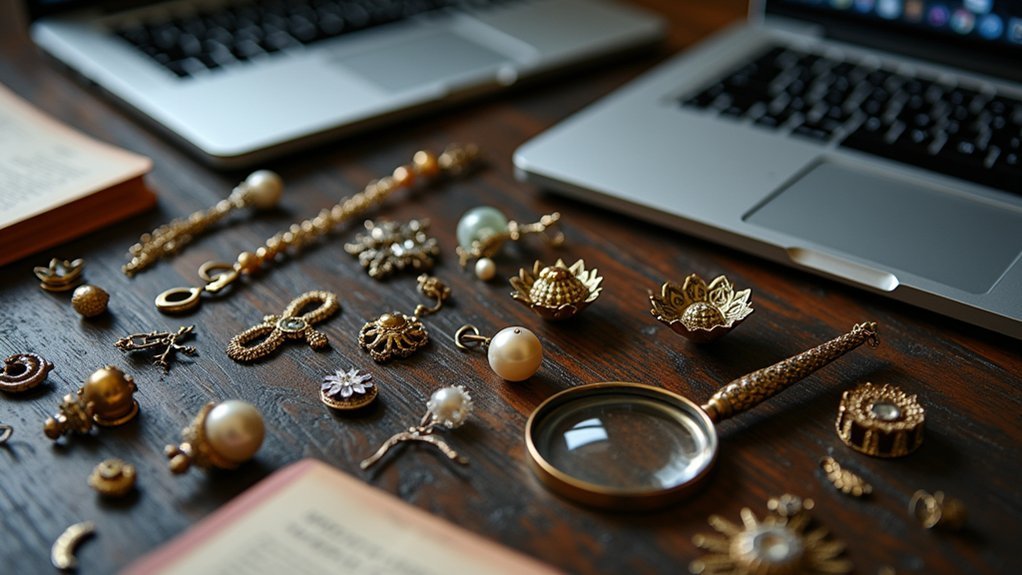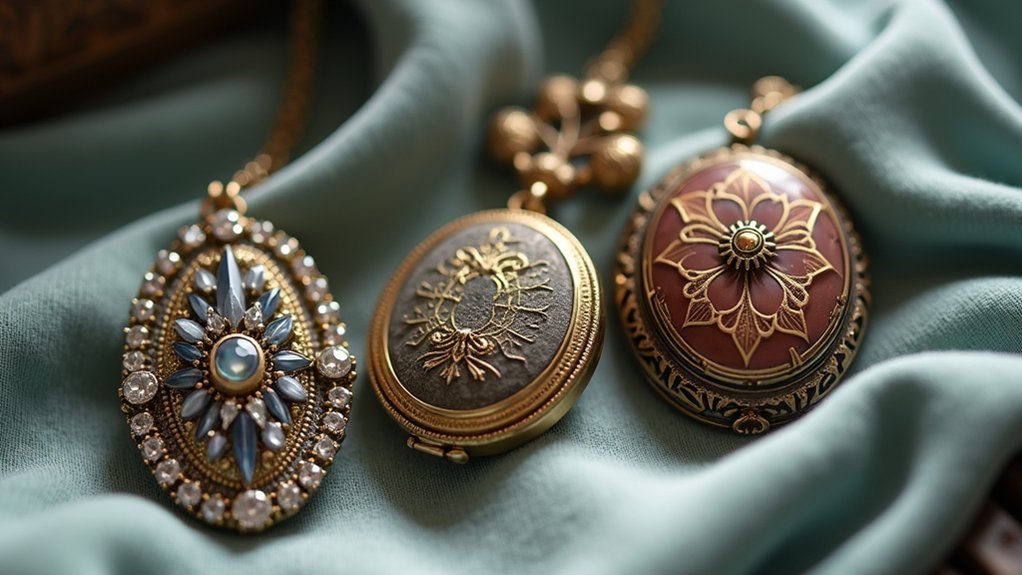You’ll need to authenticate maker’s marks by researching specific symbols, signatures, and triple signed bottoms that indicate reputable manufacturers. Next, assess the condition by examining wear patterns, chips, cracks, and hand-painted details under proper lighting to evaluate craftsmanship quality. Finally, research market value using eBay’s completed listings, pottery mark databases, and auction sites to analyze pricing trends. These three methods form the foundation for accurately determining your vintage adornment’s worth and potential.
Authenticating Maker’s Marks and Historical Signatures

When you’re examining vintage adornment parts, authenticating maker’s marks and historical signatures becomes your first line of defense against counterfeits and misattributed pieces.
You’ll want to research specific symbols and signatures that indicate manufacturers, as reputable makers have distinct, well-documented marks. Make sure you understand the historical context, including production timelines and geographical origins, which enhances authentication accuracy for pieces from specific eras or regions.
Look for triple signed bottoms or inscriptions, which considerably increase value and serve as reliable authenticity indicators.
Triple signed pieces serve as gold standards in authentication, dramatically boosting both collector confidence and market value.
You can utilize online databases, pottery mark guides, and auction archives to identify and verify marks. When examining any artist signature, consult expert appraisers specializing in vintage jewelry and adornments for additional authentication assurance and accurate valuation.
Assessing Condition and Craftsmanship Quality
Once you’ve verified authenticity through maker’s marks, you’ll need to conduct a thorough condition evaluation that examines every surface for wear patterns, chips, cracks, and any restoration work that could impact the piece’s market value.
Evaluating condition requires careful inspection under proper lighting to identify subtle damage or repairs that aren’t immediately visible.
When evaluating craftsmanship quality, look for intricate hand-painted details and relief decorations that demonstrate superior artistry. Gold-painted edges often indicate higher-quality pieces worth more than mass-produced alternatives.
Use vintage adornment grading systems to establish consistent evaluation standards—higher grades reflect better preservation and superior workmanship. Document any signs of previous restoration, as original condition typically commands premium pricing over restored pieces.
Researching Market Value Through Online Resources

How can you determine what your vintage adornment parts are actually worth in today’s market? Online resources provide powerful tools for accurate valuation. Start with eBay’s completed listings to see what similar vintage adornment parts actually sold for recently. Use Google Images to identify specific pieces and understand their design significance. Reference pottery mark databases to confirm makers and establish provenance.
| Resource Type | Primary Use | Value Added |
|---|---|---|
| eBay Completed Listings | Current market value | Real sale prices |
| Google Images | Item identification | Design context |
| Pottery Mark Databases | Maker verification | Provenance confirmation |
Join vintage collecting forums and social media groups for insider insights. Auction sites reveal historical pricing trends and demand patterns. These combined resources help establish accurate market value assessments.
Frequently Asked Questions
How Do You Find Out What Vintage Items Are Worth?
You’ll research completed sales on eBay, consult online databases for maker’s marks, visit expert appraisers, check condition grading systems, and join collector forums to determine your vintage items’ current market value.
How Do You Appraise Vintage Items?
You’ll research the item’s history and manufacturer, examine its condition thoroughly, identify maker’s marks, check completed sales on auction sites, and consult expert appraisers for validation.
How Do You Determine the Value of a Collectible?
You’ll research the item’s production history and rarity, authenticate maker’s marks, assess condition using grading standards, compare recent sales on auction sites, and consult expert appraisers for thorough valuation.
How to Assess the Value of Antique Furniture?
You’ll examine joinery techniques, materials, and craftsmanship details. Research maker’s marks for authenticity, evaluate condition and historical significance, then compare similar pieces through auction sites to determine fair market value.
In Summary
You’ve learned three essential methods for accurately valuing vintage adornment parts. By authenticating maker’s marks, you’ll verify authenticity and origin. When you assess condition and craftsmanship, you’re determining quality factors that directly impact worth. Through thorough market research using online resources, you’ll establish current pricing trends. Apply these techniques systematically, and you’ll develop confidence in appraising vintage pieces. Remember, successful valuation combines all three approaches rather than relying on just one method alone.





Leave a Reply